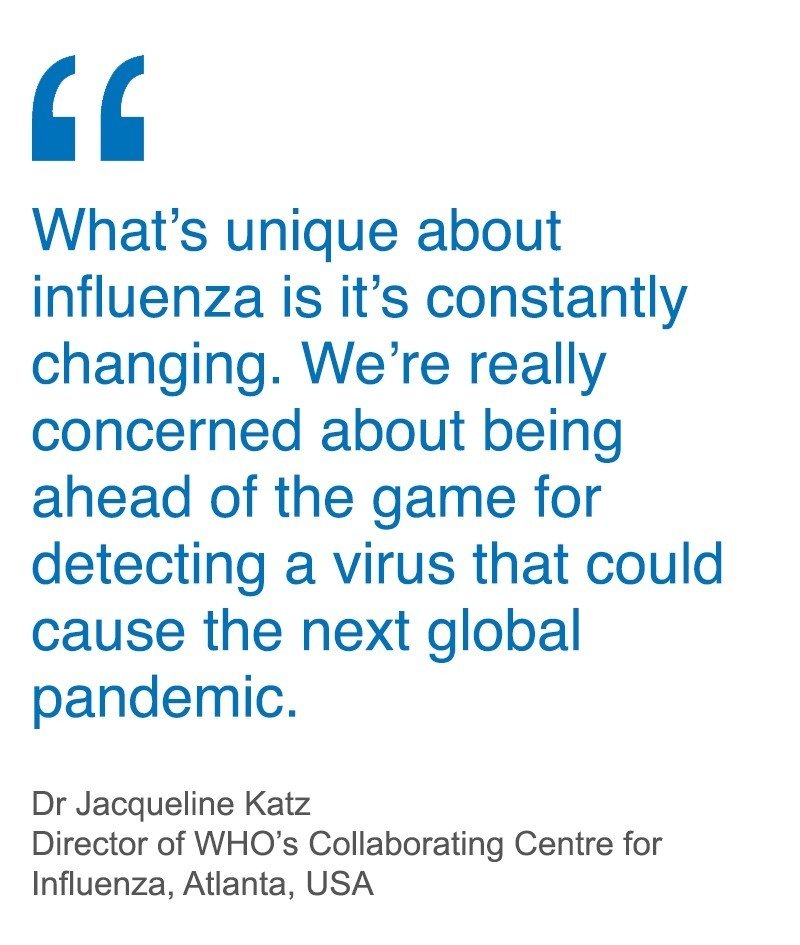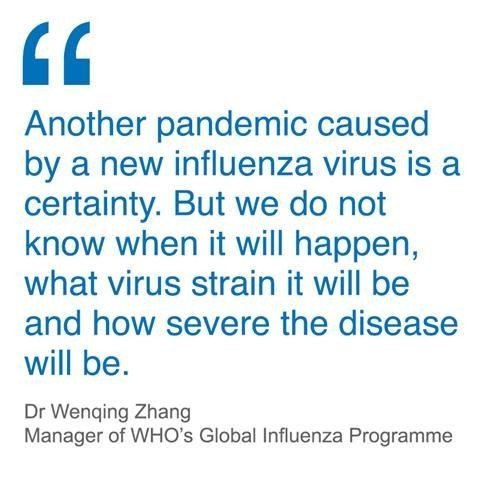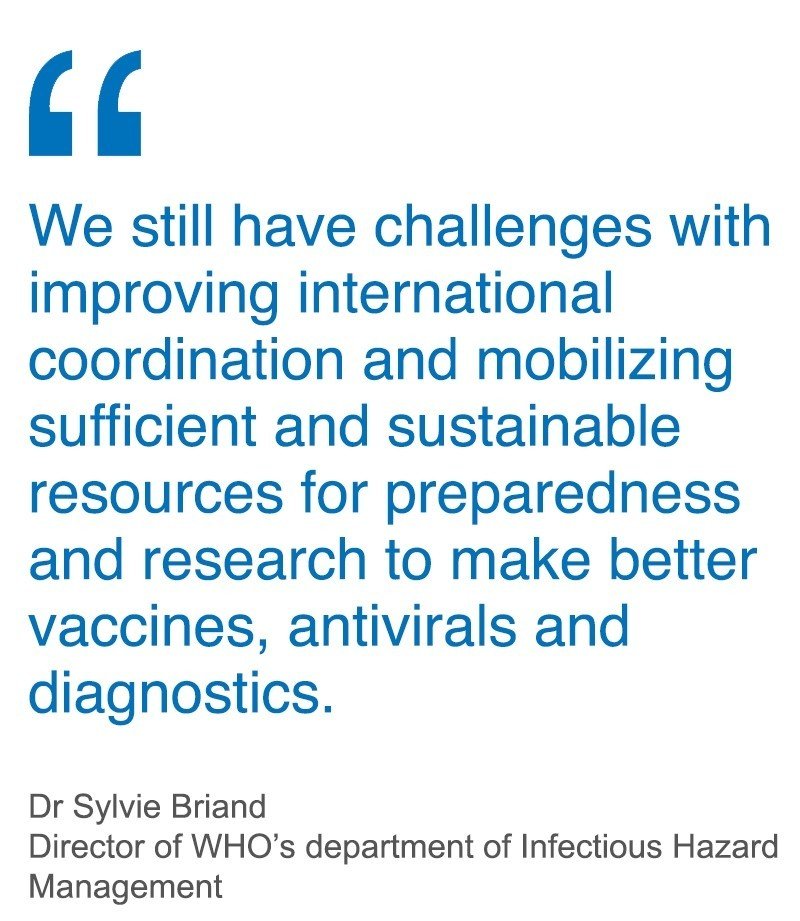
100年前の「スペイン風邪」は戦争の全死者より多かった! Influenza: are we ready? インフルエンザの用意はいい?
The flu comes around every year, everywhere - and children are among some of the most vulnerable. We asked children around the world to illustrate this Spotlight. The drawings are by children aged 5-15 years from Australia, China, the Democratic Republic of the Congo, Denmark, El Salvador, France, Latvia, Switzerland and Tajikistan.
-------------------------------
When 100 passengers on a flight from Dubai to New York in September 2018 fell ill with respiratory symptoms, health officials were concerned that they might be carrying a serious respiratory illness called MERS-CoV (Middle East respiratory syndrome coronavirus) and quarantined the plane until further health checks could be completed. Testing showed that several were positive for the influenza virus, which can be easily spread when people are in close contact or in contained spaces such as airports and planes for several hours.
Influenza may not always be thought of by most people as a serious illness – the symptoms of headaches, runny nose, cough and muscle pain can make people confuse it with a heavy cold. Yet seasonal influenza kills up to 650 000 people every year. That is why influenza vaccinations are so important, especially to protect young children, older people, pregnant women, or people who have vulnerable immune systems (click here for a Facebook live with Dr Martin Friede on the flu vaccine).
What most of us think of as ‘the flu’ is seasonal influenza, so called because it comes around in the coldest season twice a year (once in the Northern hemisphere’s winter, and once in the Southern hemisphere’s winter) in temperate zones of the world, and circulates year-round in the tropics and subtropics.
The influenza virus is constantly mutating – essentially putting on ever-changing disguises – to evade our immune systems. When a new virus emerges that can easily infect people and be spread between people, and to which most people have no immunity, it can turn into a pandemic. "Another pandemic caused by a new influenza virus is a certainty. But we do not know when it will happen, what virus strain it will be and how severe the disease will be,” said Dr Wenqing Zhang, the manager of WHO’s Global Influenza Programme. “This uncertainty makes influenza very different to many other pathogens,” she said.
2018 marks the 100th anniversary of one of the most catastrophic public health crises in modern history, the 1918 influenza pandemic known colloquially as “Spanish flu”. This Spotlight focuses on the lessons we can learn from previous flu pandemics, how prepared we are for another one, and how work on seasonal flu can boost capacity for pandemic preparedness.
2018年9月のドバイからニューヨークへのフライトで100人の乗客が呼吸器症状で病気になったとき、保健当局はMERS-CoV(中東呼吸器症候群コロナウイルス)と呼ばれる深刻な呼吸器疾患を抱えている可能性を懸念し、さらに飛行機を検疫しました。ヘルスチェックを完了することができました。テストの結果、いくつかのインフルエンザウイルスが陽性であることが判明しました。インフルエンザウイルスは、人々が数時間近く、空港や飛行機などの狭いスペースにいる場合に簡単に広がります。
インフルエンザは、ほとんどの人が常に深刻な病気だと考えているとは限りません。頭痛、鼻水、咳、筋肉痛の症状により、風邪と混同される可能性があります。しかし、季節性インフルエンザは毎年最大65万人を殺します。だからこそ、特に幼児、高齢者、妊娠中の女性、または免疫系が脆弱な人たちを守るために、インフルエンザの予防接種が非常に重要です。
私たちのほとんどが「インフルエンザ」と考えているのは季節性インフルエンザです。世界の温暖な地域で年に2回(北半球の冬に1回、南半球の冬に1回)最も寒い季節に発生するためです。 、熱帯、亜熱帯で一年中流通しています。
インフルエンザウイルスは絶えず変化しており、本質的に絶えず変化する変装を加えて、免疫システムを回避しています。人々に簡単に感染し、人々の間に広がり、ほとんどの人々が免疫を持たない新しいウイルスが出現すると、パンデミックになります。 「新しいインフルエンザウイルスによって引き起こされる別のパンデミックは確実です。しかし、それがいつ起こるのか、どのウイルス株で、どの程度重症になるのかはわかりません」とWHOのグローバルインフルエンザプログラムのマネージャーであるWenqing Zhang博士は述べました。 「この不確実性により、インフルエンザは他の多くの病原体とは大きく異なります」と彼女は言いました。
2018年は、現代史で最も壊滅的な公衆衛生危機の1つである「スペイン風邪」として口語で知られる1918年のインフルエンザの大流行の100周年を迎えます。このスポットライトは、以前のインフルエンザのパンデミックから学べる教訓、別のインフルエンザの流行に対する準備、季節性インフルエンザへの取り組みがパンデミック対策の能力を高める方法に焦点を当てています。
--------------------------------------
The 1918 flu pandemic
The intensity and speed with which the 1918 influenza pandemic struck were almost unimaginable – infecting one-third (around 500 million people) of the Earth’s population. By the time the pandemic subsided two years later, more than 50 million people are estimated to have died. Globally, the death toll eclipsed that of the First World War, which was around 17 million.
There was actually nothing “Spanish” about the 1918 pandemic. While it had already taken a big toll in France and the USA, it was not made public in those countries because of wartime censorship. French doctors even referred to it by the code name “Maladie Onze”, meaning "disease 11”. When the disease surfaced in Spain, which was neutral during the war, the country had no censorship in place and so made the first public reports of the pandemic. The name stuck.
1918年のインフルエンザのパンデミックが襲った強さと速度は、ほとんど想像もできませんでした。地球人口の3分の1(約5億人)に感染しています。 2年後にパンデミックが沈静化するまでに、5000万人以上が死亡したと推定されています。世界的には、死者数は第一次世界大戦の死者数を上回りました。
1918年のパンデミックについては、実際には「スペイン語」はありませんでした。フランスとアメリカではすでに大きな犠牲を払っていましたが、戦時の検閲のためにそれらの国では公表されませんでした。フランスの医師たちは、「病気11」を意味するコード名「マラディオンゼ」でそれを参照しました。戦争で中立だったスペインで病気が表面化したとき、国には検閲がありませんでした。パンデミック。
A unique disease ユニークな病(やまい)

Pathogens ignore national borders, social class, economic status, and even age. While influenza is typically more deadly in very young or elderly people, the 1918 influenza pandemic, for instance, was unusually fatal among men aged 20 to 40 years.
病原体は、国境、社会階級、経済的地位、そして年齢さえも無視します。インフルエンザは通常、非常に若い人や高齢者の方が致命的ですが、1918年のインフルエンザのパンデミックは、20歳-40歳の男性では異常に致命的でした。
パンデミックは、経済や学校、仕事、その他の大衆集会などの社会的機能を混乱させます。また、インフルエンザのパンデミックは、国の医療制度の全体的な機能に重大な影響を与える可能性があります。これは、資源と医療従事者に大きく影響するためです。
インフルエンザのパンデミックは毎年600億米ドルの費用がかかると予測されていますが、 「対照的にパンデミックへの備えは年間45億米ドルしかかかりません」。
他の多くの病気と同様に、インフルエンザのパンデミックは、貧しく社会的に疎外されたコミュニティに最も大きな影響を与えます。 1918年のようなパンデミックが現代世界に及ぼす潜在的な影響を調べたThe Lancetの研究では、「パンデミックに備える余裕が最も少ない国と地域が最も影響を受ける」ことが判明しました。
Pandemics disrupt the economy and social functions like school, work and other mass gatherings. An influenza pandemic would also likely have significant impacts on the overall functioning of a country's health system, as it would draw heavily on resources and health workers.
A flu pandemic is predicted to cost US$60 billion every year, but pandemic preparedness in contrast, could cost only US$4.5 billion a year.
Just as with many other diseases, influenza pandemics impact poor and socially marginalized communities the hardest. A study in The Lancet looking at the potential impact of a 1918-like pandemic on the modern world found that "the countries and regions that can least afford to prepare for a pandemic will be affected the most."
The world looks very different than it did 100 years ago, however. Unlike the world affected by the 1918 influenza pandemic, we now have antivirals, vaccines, diagnostic tests, and modern surveillance techniques. Many of these advances were spearheaded by WHO in close collaboration with other agencies and national and regional institutions. We also have learned from subsequent pandemics in the 20th and 21st century.
As this Spotlight will show, we have more tools to combat pandemics than ever before. These include the development of a global influenza surveillance system that constantly monitors the evolution of circulating influenza strains, the development of an unprecedented agreement to ensure sharing of flu viruses and data alongside strengthening global preparedness capacities, efforts to continuously improve the effectiveness of the seasonal influenza vaccine, and powerful new antivirals. However, for the next influenza pandemic, there are still challenges ahead and in particular ensuring optimum global collaboration between all countries in the world and defining mechanisms that allow equitable access to vaccines, treatments and diagnostics for everyone, everywhere.
"We have the ability, now more than ever, to mitigate the impact of diseases, save lives and reduce economic and social costs. But countries' preparedness efforts should be maintained and should integrate innovative lifesaving interventions," said Dr Sylvie Briand, director of WHO’s department of Infectious Hazard Management.
しかし、世界は100年前とは大きく異なります。 1918年のインフルエンザパンデミックの影響を受けた世界とは異なり、現在、抗ウイルス薬、ワクチン、診断テスト、最新サーベイランステクニックがあります。これらの進歩の多くは、他機関や国内および地域の機関との緊密な協力のもとで、WHOが先頭に立っています。また、20世紀-21世紀のその後のパンデミックからも学びました。
このSpotlightが示すように、パンデミックに対抗するためのツールがこれまでになく多くあります。これらには、循環インフルエンザ-株の進化を絶えず監視するグローバルなインフルエンザ監視システムの開発、グローバルな準備能力の強化とともに、インフルエンザウイルスとデータの共有を確保するための前例のない合意の開発、季節性インフルエンザの有効性を継続的に改善する取り組みが含まれますワクチン、強力な新しい抗ウイルス薬。しかし、次のインフルエンザのパンデミックにはまだ課題があり、特に世界中のすべての国の間で最適なグローバルコラボレーションを確保し、あらゆる場所のすべての人がワクチン、治療、診断に公平にアクセスできるメカニズムを定義しています。
「病気の影響を軽減し、人命を救い、経済的および社会的コストを削減する能力が今まで以上にあります。しかし、各国の準備努力を維持し、革新的な救命介入を統合する必要があります」 WHOの感染性ハザード管理部門。
Predictably unpredictable 予測不可能な予測可能

Pandemic influenza outbreaks are unpredictable. One million people around the world died in a 1957 outbreak that started in China but spread globally. In 1968, another outbreak took an estimated 1-3 million lives. In 2003, the re-emergence of A(H5N1) or so-called avian influenza, highlighted how the virus could pass from animals to people, but it did not reach the pandemic stage because it could not pass sustainably from person to person.
パンデミックインフルエンザの発生は予測不能です。 1957年の中国での発生から世界中で100万人が亡くなりました。 1968年には、別のアウトブレイクで推定1〜3百万人の命が奪われました。 2003年、A(H5N1)またはいわゆる鳥インフルエンザの再出現は、ウイルスが動物から人にどのように伝染するかを強調しましたが、人から人に持続的に伝染できないため、パンデミックステージに達しませんでした。

The 2009 “Swine flu” A(H1N1) pandemic started in Mexico where it caused severe illness in previously healthy adults and spread rapidly to over 214 countries and overseas territories or communities. Between 105 000 and 395 000 people are thought to have died. Even so, the world was relatively lucky: it turned out to be milder than some seasonal epidemics, which can kill twice that number.
An international committee convened by WHO reviewed the response to the 2009 pandemic and found that “The world is ill-prepared to respond to a severe influenza pandemic or to any similarly global, sustained and threatening public-health emergency.” The committee called for not only the strengthening of core public-health capacities, but also increased research, a multisectoral approach, strengthened health-care delivery systems, economic development in low and middle-income countries and improved health status.
2009年の「豚インフルエンザ」A(H1N1)パンデミックはメキシコで始まり、以前は健康な成人に重篤な病気を引き起こし、214を超える国と海外の地域とコミュニティに急速に広がりました。 105 000〜395 000人が死亡したと考えられています。それでも、世界は比較的幸運でした。それは、その数の2倍を殺す季節的な流行よりも穏やかであることが判明しました。
WHOが招集した国際委員会は、2009年のパンデミックへの対応をレビューし、「世界は深刻なインフルエンザのパンデミックや、同様の世界的で持続的かつ脅威的な公衆衛生緊急事態に対応する準備ができていない」。と判断しました。中核的な公衆衛生能力の強化のみならず、研究の増加、多部門的アプローチ、医療提供システムの強化、低中所得国の経済発展、健康状態の改善。
In 1947, a year before WHO`s constitution came into force, the WHO Interim Committee of the United Nations established a Global Influenza Programme to track changes in the virus. The sharing of viruses and data between different nations in order to have up-to-date vaccines thus became one of the core tools in the fight against both seasonal and pandemic influenza.
In 1952, WHO launched the Global Influenza Surveillance Network with 26 collaborating laboratories around the world. Today, renamed the Global Influenza Surveillance and Response System (GISRS), the 66-year old network comprises 153 institutions in 114 countries. It constantly monitors influenza viruses causing seasonal outbreaks in people, zoonotic outbreaks, and potential pandemics and makes vaccine selection decisions twice a year, for the northern and southern hemisphere influenza seasons. Countries with National Influenza Centres share virus samples and data to support this continuous monitoring.
"GISRS is the frontline in the fight against influenza. It is one of the oldest and most significant examples of international cooperation for public health,” said Dr Zhang. "Confidence, trust and sharing, with commitment from Member States, is critical to pandemic preparedness."
WHOの憲法が施行される1年前の1947年、国連のWHO暫定委員会は、ウイルスの変化を追跡するためにグローバルインフルエンザプログラムを設立しました。したがって、最新のワクチンを保有するために異なる国間でウイルスとデータを共有することは、季節性インフルエンザとパンデミックインフルエンザの両方に対する戦いの中心的なツールの1つになりました。
1952年に、WHOは、世界中の26の共同研究室とともに、Global Influenza Surveillance Networkを立ち上げました。今日、66年の歴史を持つネットワークは、114か国の153機関で構成され、グローバルインフルエンザ監視と対応システム(GISRS)に改名されました。北半球および南半球のインフルエンザシーズンについて、人々の季節的流行、人獣共通流行、潜在的なパンデミックを引き起こすインフルエンザウイルスを常に監視し、年に2回ワクチンの選択を決定します。国立インフルエンザセンターを持つ国は、この継続的な監視をサポートするために、ウイルスのサンプルとデータを共有しています。
「GISRSは、インフルエンザとの闘いの最前線です。公衆衛生のための国際協力の最古、最も重要な例の1つです」と、Zhang博士は述べています。準備。

"Pandemic influenza is a significant public health issue that we are unable to prevent or eliminate, given our current technology and knowledge. So much of our work managing the pandemic has to be when it occurs, to impact on health and society," said Dr Zhang. "Seasonal influenza epidemics provide real opportunities to prepare for the next pandemic. To achieve the best possible outcome now and in the future, there are three critical factors: timeliness and quality of virus and information sharing, research and innovation, and global coordination. For pandemic influenza, the world has to work as one team," she said.
Every week, countries report newly detected influenza cases to WHO through a system called FluNet. Another system, FluID, looks at the epidemiology of the circulating viruses associated with influenza. WHO is also developing a pandemic influenza severity assessment tool (PISA) to provide baselines so that there is a barometer by which to compare the virulence of the virus as new strains emerge.
“What's unique about influenza is it is constantly changing. So for seasonal viruses, these viruses continue to evolve and change and escape the ability of existing vaccines to protect the population,” said Dr Jacqueline Katz, Director of the WHO Collaborating Centre for the Surveillance, Epidemiology and Control of Influenza, Atlanta, USA. “We're really concerned about being ahead of the game for detecting a virus that could cause the next global pandemic."
「パンデミックインフルエンザは重大な公衆衛生の問題であり、現在の技術と知識から、予防または排除することはできません。パンデミックの管理作業の大部分は、それが発生したときに健康と社会に影響を与えるものです」。 「季節性インフルエンザの流行は、次のパンデミックに備える真の機会を提供します。現在、将来の最良の結果を達成するために、ウイルスと情報共有の適時性と品質、研究と革新、グローバルな調整という3つの重要な要素があります。パンデミックインフルエンザ、世界は1つのチームとして動作する必要があります」と彼女は言いました。
毎週、各国は、FluNetと呼ばれるシステムを通じて、新たに検出されたインフルエンザの症例をWHOに報告しています。別のシステムFluIDは、インフルエンザに関連する循環ウイルスの疫学を調べます。 WHOはまた、パンデミックインフルエンザの重症度評価ツール(PISA)を開発してベースラインを提供し、新しい株が出現した場合のウイルスの毒性を比較するためのバロメーターを用意しています。
「インフルエンザのユニークな点は、常に変化していることです。そのため、季節性ウイルスについては、これらのウイルスは進化を続け、既存のワクチンが人口を保護する能力を逃れます」と、米国アトランタのインフルエンザの疫学管理に関するWHO協力センターのディレクターであるジャクリーン・カッツ博士は述べています。 「私たちは、次のグローバルなパンデミックを引き起こす可能性のあるウイルスを検出するために、ゲームの先を行くことを本当に心配しています。

Pandemic preparedness パンデミックへの備え
The re-emergence in 2004 of a highly virulent influenza virus with pandemic potential triggered global discussions about access to pandemic vaccines by developing countries. Some countries, affected by high numbers of human infections, voiced concern that they were sharing virus samples with GISRS, while knowing that if a pandemic were to occur, they might not have access to the vaccines made using information and materials from those samples. To strengthen the sharing of influenza viruses with human pandemic potential and to increase the access of developing countries to vaccines and other critical pandemic response supplies, the Pandemic Influenza Preparedness (PIP) Framework was set up in 2011 by the 194 Member States of WHO. This framework would help countries in need to access vaccines, antivirals, and diagnostics at the time of a pandemic.
Two of the main benefits of the agreement are: first, vaccine manufacturers that receive vaccine viruses from GISRS must commit to provide to WHO about 10% of their future pandemic vaccine production, so that it can be distributed to countries in need at the time of the next pandemic. Second, influenza product manufacturers that use GISRS are expected to contribute US$28 million a year to WHO that then uses the funds to bolster the ability of countries to respond to pandemics.
2004年にパンデミックの可能性がある非常に病原性の高いインフルエンザウイルスが再出現したことにより、開発途上国によるパンデミックワクチンへのアクセスに関する世界的な議論が始まりました。多数のヒト感染症の影響を受けた一部の国は、ウイルスのサンプルをGISRSと共有しているという懸念を表明しましたが、パンデミックが発生した場合、それらのサンプルの情報と資料を使用して作成されたワクチンにアクセスできない可能性があることを知っていました。インフルエンザウイルスと人間のパンデミックの可能性との共有を強化し、発展途上国ワクチンやその他重要なパンデミック対応物資へのアクセスを増やすため、パンデミックインフルエンザ対策(PIP)フレームワークは、WHO 194加盟国によって2011年に設立されました。このフレームワークは、パンデミック時にワクチン、抗ウイルス薬、診断薬にアクセスする必要がある国を支援します。
協定の主な利点は次の2つです。まず、GISRSからワクチンウイルスを受け取ったワクチン製造業者は、将来のパンデミックワクチン生産の約10%をWHOに提供することを約束する必要があります。次のパンデミック。第二に、GISRSを使用するインフルエンザ製品メーカーは、年間2800万米ドルをWHOに寄付し、その資金を使用して、各国がパンデミックに対応する能力を強化することが期待されています。
"By working with industry partners, we can strengthen global preparedness capacities in countries where they are weak. In return, countries are enabling the GISRS network to perform a thorough risk assessment by sharing influenza viruses with pandemic potential," said Anne Huvos, manager of the PIP Framework secretariat at WHO.
「業界パートナーと協力することで、脆弱国のグローバルな準備能力を強化できます。見返りに、各国はパンデミックの可能性があるインフルエンザウイルスを共有することにより、GISRSネットワークが徹底的なリスク評価を実行できるようにします」。と、Anne HuvosのマネージャーWHO: PIPフレームワーク事務局。
Are we ready for the next pandemic?
Influenza is an ever-evolving disease, so the work on prevention, preparedness and response has to adapt continuously to keep up with these changes.
WHO and partners are developing a renewed Global Influenza Strategy to be launched this year. This will support countries in developing seasonal influenza prevention and control capacities. These national efforts, in turn, will build greater global preparedness for the next pandemic. The strategy focuses on three priorities, strengthening pandemic preparedness, expanding seasonal influenza prevention and control and research and innovation. Research and innovation includes improved modelling and forecasting of influenza outbreaks, along with the development of new vaccines, including a possible universal influenza vaccine that would work against all influenza virus strains.
However, developing and distributing a vaccine during a pandemic could take up to a year. This means that non-pharmaceutical measures - the same as those needed to stop seasonal flu - will be critical. Some of these are actions that individuals can take, including staying home when sick and washing hands frequently.
次、パンデミックの準備はできていますか?
インフルエンザは常に進化している病気であるため、予防、準備、対応に関する作業は、これらの変化に対応するために継続的に適応する必要があります。
WHOとパートナーは、今年開始される新たなグローバルインフルエンザ戦略を策定しています。これは、季節的なインフルエンザの予防と制御能力を開発する国を支援します。これらの国の取り組みは、次のパンデミックに対するより大きなグローバルな準備を構築します。この戦略は、3つの優先事項、パンデミックへの備えの強化、季節性インフルエンザの予防と制御、研究と革新の拡大に焦点を当てています。研究と革新には、インフルエンザの発生の改善されたモデリングと予測、およびすべてのインフルエンザウイルス株に対して機能する可能性のあるユニバーサルインフルエンザワクチンなどの新しいワクチンの開発が含まれます。
ただし、パンデミックの際にワクチンを開発および配布するには、最大1年かかります。これは、季節性インフルエンザを止めるために必要なものと同じ-非医薬品対策が重要であることを意味します。これらのいくつかは、病気のときに家にいて、頻繁に手を洗うなど、個人がとることができる行動です。

Organizations could also take measures such as such as implementing policies to limit gatherings where the virus may be easily spread; WHO is currently developing guidance on such measures. These new guidelines will draw on evidence as well as experience from the 1918 and 2009 pandemics. However, even with the best infection prevention and control measures, some people will still fall ill with influenza – for people with severe influenza, there are effective antivirals to cure it.
Today, less than half of all countries have a national influenza pandemic preparedness plan; of those, few have updated their plans to take into account the lessons learned from 2009. Not surprisingly, low-income countries, which are struggling to bolster their own primary health care systems, often lack the resources or bandwidth to develop and implement pandemic preparedness plans.
組織は、ウイルスが容易に拡散する可能性のある収集を制限するポリシーを実効するなどの手段を講じることもできます。 WHOは現在、このような対策に関するガイダンスを作成しています。これらの新しいガイドラインは、1918年と2009年のパンデミックからの経験と経験に基づいています。しかし、最良の感染予防と制御対策を講じたとしても、一部の人々は依然としてインフルエンザで病気になります。重度のインフルエンザの人々には、それを治療する効果的な抗ウイルス薬があります。
今日、すべての国の半分未満が国家インフルエンザのパンデミック対策計画を持っています。驚くことではないが、独自のプライマリヘルスケアシステムを強化するのに苦労している低所得国では、パンデミック対策を開発および実装するためのリソースや帯域幅が不足していることが多い。

At the core of effective pandemic response is a strong, well-resourced health system that includes adequately trained and paid health workers; functioning water, sanitation, and hygiene systems; quality laboratory services for rapid diagnosis; access to medical products including vaccines; and reliable systems for tracking and reporting cases of the disease.
"We still have challenges with improving international coordination and mobilizing sufficient and sustainable resources for preparedness and research to make better vaccines, antivirals and diagnostics," said Dr Briand. "Most importantly, these counter-measures need to be available to all countries, particularly those communities with the least resources as they will be the most vulnerable in the next flu pandemic."
Some of this content first appeared in Pandemic influenza: an evolving challenge.
効果的なパンデミック対策の中核となるのは、十分に訓練された有給の医療従事者を含む強力でリソースの豊富な医療システムです。機能する水、衛生、衛生システム。迅速な診断のための質の高い検査サービス。ワクチンを含む医療製品へのアクセス。病気の症例を追跡および報告するための信頼できるシステム。
「国際的な調整を改善し、より良いワクチン、抗ウイルス薬、診断薬を製造するための準備と研究のための十分かつ持続可能な資源を動員するという課題があります」とブリアン博士は述べました。 「最も重要なことは、これらの対策はすべての国、特に次のインフルエンザのパンデミックで最も脆弱になるため、リソースが最も少ないコミュニティに利用可能である必要があります。」
このコンテンツの一部は、パンデミックインフルエンザに初めて登場しました。これは進化する課題です。
この記事が気に入ったらサポートをしてみませんか?
